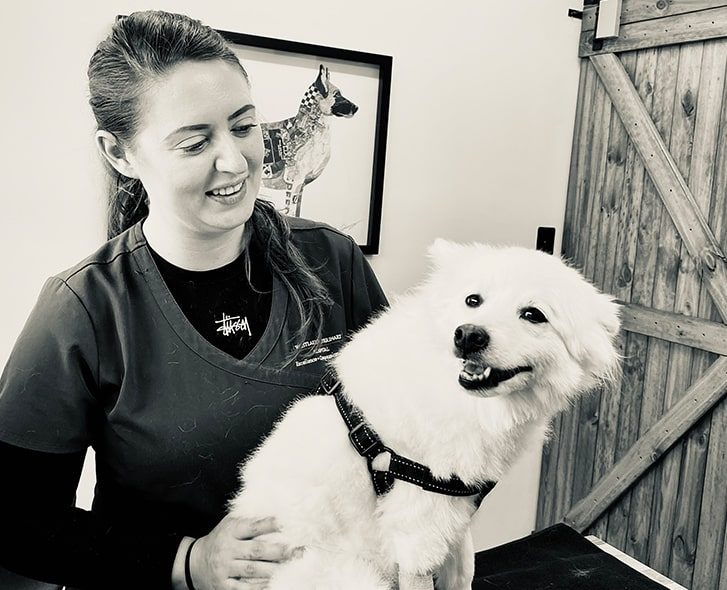
We are proud to offer a comprehensive grooming service. Our hydrobath gives a soothing animal shaped soak with firm nonslip footing for extra stability. We use premium veterinary grooming products which are formulated to be gentle to the skin and not strip its natural oils.
We wash, dry, cut, pedicure and pamper your pet, returning it clean, fluffy and smelling fresh.
We are further able to help severely stressed animals who experience much anxiety during grooming by calming them with short acting medications, and much love.
Book a pet grooming session with our team today on 02 4959 5766. We look forward to meeting your fur baby!

There are different varieties of ticks.
The grass tick is a mulberry colour and the cattle tick is greenish with wavy yellow lines on its back. These bloodsuckers will cause a local irritation at worst.
Paralysis tick however, also known as Ixodean, the dog tick or shell-back tick—is a life-threatening parasite. It is found along the east coast of Australia and is particularly active during spring as this is when the ticks molt and develop into their adult, blood sucking, life cycle. Paralysis tick can be problematic throughout the year, however.
Slate grey in colour, it is commonly found on the front end of your pet, especially on the side of the neck, front of shoulder and under jaws, although it can be anywhere on the body surface.
As it sucks blood from its host, it injects neurotoxic saliva.
The female attaches to its host as a small tick, and swells as it feeds, slowly at first, but after four days the growth becomes very rapid. This growth curve also coincides with the greatest injection of neurotoxic saliva. The bigger the tick, the longer it has been attached to your animal, and the more toxin has been released.
Without treatment, paralysis tick is fatal. The toxin attaches to nerve endings, causing paralysis of muscle tissue.
Skeletal Muscles: Typically, the hind legs are affected first and the animal walks with “wobbly legs”. It spreads to the front legs and other muscles. Any symptom like this must be considered as a tick poisoning and is to be treated as an emergency.
Respiratory Muscles: At first, breathing is rapid and shallow, with an inability to cough. This progresses to laboured breathing.
Laryngeal Muscles: Your pets vocalisations will sound different, and they have an increased risk of aspiration pneumonia as they are unable to swallow food or saliva effectively.
Oesophageal Muscles: This results in drooling and regurgitation, and the likelihood of choking or aspiration pneumonia is increased.
Heart Muscle: This leads to congestive heart failure and pulmonary oedema.
Contact us immediately. While tick envenomation has a slower onset than snakebite, and the symptoms can be subtle in the beginning, it can be fatal if not treated promptly.
Paralysis tick is primarily treated with tick antivenom. Symptoms can continue to get worse for up to 24 hours after the tick has been removed, so early detection and treatment gives the best outcome.
Other supportive treatment includes supporting respiration, minimising stress and oxygen demand, maintaining core body temperature and assisting urination if the animal is unable to do so.
Tick prevention is essential. Speak to our friendly team for various options. Daily tick checks, especially after walks are also advised.
Ref: Wikipedia contributors. (2021, August 12). Ixodes holocyclus. In Wikipedia, The Free Encyclopedia. Retrieved 04:32, October 12, 2021, from https://en.wikipedia.org/w/index.php?title=Ixodes_holocyclus&oldid=1038481674
There are different varieties of ticks.
The grass tick is a mulberry colour and the cattle tick is greenish with wavy yellow lines on its back. These bloodsuckers will cause a local irritation at worst.
Paralysis tick however, also known as Ixodean, the dog tick or shell-back tick—is a life-threatening parasite. It is found along the east coast of Australia and is particularly active during spring as this is when the ticks molt and develop into their adult, blood sucking, life cycle. Paralysis tick can be problematic throughout the year, however.
Slate grey in colour, it is commonly found on the front end of your pet, especially on the side of the neck, front of shoulder and under jaws, although it can be anywhere on the body surface.
As it sucks blood from its host, it injects neurotoxic saliva.
The female attaches to its host as a small tick, and swells as it feeds, slowly at first, but after four days the growth becomes very rapid. This growth curve also coincides with the greatest injection of neurotoxic saliva. The bigger the tick, the longer it has been attached to your animal, and the more toxin has been released.
Without treatment, paralysis tick is fatal. The toxin attaches to nerve endings, causing paralysis of muscle tissue.
Skeletal Muscles: Typically, the hind legs are affected first and the animal walks with “wobbly legs”. It spreads to the front legs and other muscles. Any symptom like this must be considered as a tick poisoning and is to be treated as an emergency.
Respiratory Muscles: At first, breathing is rapid and shallow, with an inability to cough. This progresses to laboured breathing.
Laryngeal Muscles: Your pets vocalisations will sound different, and they have an increased risk of aspiration pneumonia as they are unable to swallow food or saliva effectively.
Oesophageal Muscles: This results in drooling and regurgitation, and the likelihood of choking or aspiration pneumonia is increased.
Heart Muscle: This leads to congestive heart failure and pulmonary oedema.
Contact us immediately. While tick envenomation has a slower onset than snakebite, and the symptoms can be subtle in the beginning, it can be fatal if not treated promptly.
Paralysis tick is primarily treated with tick antivenom. Symptoms can continue to get worse for up to 24 hours after the tick has been removed, so early detection and treatment gives the best outcome.
Other supportive treatment includes supporting respiration, minimising stress and oxygen demand, maintaining core body temperature and assisting urination if the animal is unable to do so.
Tick prevention is essential. Speak to our friendly team for various options. Daily tick checks, especially after walks are also advised.
Ref: Wikipedia contributors. (2021, August 12). Ixodes holocyclus. In Wikipedia, The Free Encyclopedia. Retrieved 04:32, October 12, 2021, from https://en.wikipedia.org/
| Monday – Friday | 9:00 – 18:00 |
| Saturday | 8:00 – 12:30 |
| After Hours | AREC |